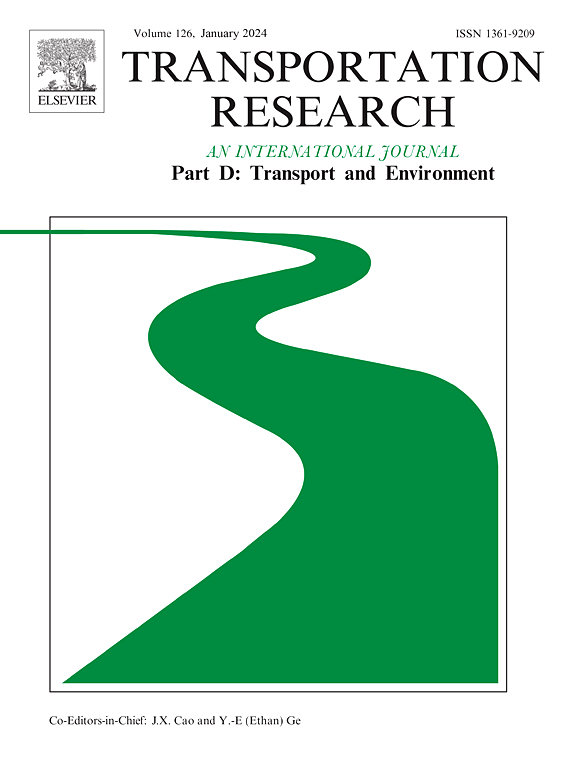Potential greenhouse gas emission reduction from active transportation: Comparing travel behavior patterns
IF 7.3
1区 工程技术
Q1 ENVIRONMENTAL STUDIES
Transportation Research Part D-transport and Environment
Pub Date : 2025-05-26
DOI:10.1016/j.trd.2025.104835
引用次数: 0
Abstract
Most research on active travel’s greenhouse gas (GHG) impacts focuses exclusively on mode shift, without examining accompanying changes in the frequency and length of trips. This study investigates the potential reduction of total GHG emissions from the expanded use of active transportation within daily travel patterns. Three scenarios are designed to represent different scopes of travel pattern changes, including changes in travel mode, the number of daily trips, and trip lengths. For each scenario, active and inactive travel mode users are compared using propensity score matching applied to the United States National Household Travel Survey data. A generalized mixed-effect model is employed to estimate the impact of increasing use of active transportation on total GHG emissions from travel. The results show that for each additional mile of daily active travel, an individual’s GHG emissions from travel are reduced by 37 % (176 g CO2e) based only on mode shift (with fixed daily trips), by 48 % (861 g CO2e) if trip lengths are also allowed to change (with a fixed number of daily trips), and by 51 % (972 g CO2e) with no constraint on daily trips. Mode shift primarily affects the shortest (and lowest-emitting) trips, so mode shift alone represents only 1/5th of the potential GHG benefits of increasing active transportation in a way that also reduces trip lengths through destination changes. This study offers a macro-level understanding of the realistic GHG reduction of expanding active transportation and provides a novel analytical framework to evaluate travel behavior changes using cross-sectional data.
主动交通的潜在温室气体减排:比较出行行为模式
大多数关于主动出行的温室气体(GHG)影响的研究只关注模式转换,而没有研究伴随的出行频率和行程长度的变化。本研究调查了在日常出行模式中扩大主动交通的使用对温室气体排放总量的潜在减少。设计了三个场景来表示旅行模式变化的不同范围,包括旅行模式的变化、每日旅行次数和旅行长度。对于每个场景,使用应用于美国国家家庭旅行调查数据的倾向得分匹配来比较活跃和不活跃的旅行模式用户。本文采用广义混合效应模型来估计主动交通工具使用增加对旅行温室气体排放总量的影响。结果表明,每增加一英里的日常活跃旅行,一个人的旅行温室气体排放量减少37%(176克二氧化碳当量),仅基于模式转换(每天固定的旅行次数),如果旅行长度也允许改变(每天固定的旅行次数),减少48%(861克二氧化碳当量),以及51%(972克二氧化碳当量)不限制每天的旅行。模式转换主要影响最短(和最低排放)的行程,因此模式转换本身只代表了增加主动交通的潜在温室气体效益的五分之一,这种方式也通过目的地的改变减少了行程长度。本研究从宏观层面上理解了主动交通的实际温室气体减排,并提供了一个新的分析框架来评估使用横截面数据的出行行为变化。
本文章由计算机程序翻译,如有差异,请以英文原文为准。
求助全文
约1分钟内获得全文
求助全文
来源期刊
CiteScore
14.40
自引率
9.20%
发文量
314
审稿时长
39 days
期刊介绍:
Transportation Research Part D: Transport and Environment focuses on original research exploring the environmental impacts of transportation, policy responses to these impacts, and their implications for transportation system design, planning, and management. The journal comprehensively covers the interaction between transportation and the environment, ranging from local effects on specific geographical areas to global implications such as natural resource depletion and atmospheric pollution.
We welcome research papers across all transportation modes, including maritime, air, and land transportation, assessing their environmental impacts broadly. Papers addressing both mobile aspects and transportation infrastructure are considered. The journal prioritizes empirical findings and policy responses of regulatory, planning, technical, or fiscal nature. Articles are policy-driven, accessible, and applicable to readers from diverse disciplines, emphasizing relevance and practicality. We encourage interdisciplinary submissions and welcome contributions from economically developing and advanced countries alike, reflecting our international orientation.

 求助内容:
求助内容: 应助结果提醒方式:
应助结果提醒方式:


